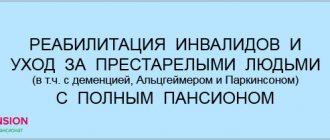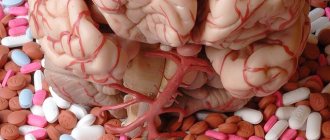Cognitive impairment in children: causes, signs and symptoms, diagnosis
The occurrence of cognitive impairment can be caused by such points in the anamnesis as:
- intrauterine hypoxia;
- hypoxia during childbirth;
- birth injuries;
- infectious diseases of the Central nervous system;
- lack of vitamins at an early age;
- brain injuries.
You should be very attentive to the development of your child’s cognitive functions if he has already been diagnosed with serious illnesses or has previously had a traumatic brain injury or an unexamined head injury.
Head injuries in children need to be approached very, very carefully, even if they seem minor at first glance. Such injuries in children are very common and account for up to 30–50% of all injuries. Every year their number increases by about 2%. In the total mass of head injuries, craniocerebral injuries are very common (up to 30% - 45% of cases). The consequences of a traumatic brain injury depend on its severity, timely assistance provided, and the age of the child.
Self-diagnosing the presence or predisposition to cognitive impairment can be done with great caution. Only a specialist can make a conclusion about the presence of violations.
Correction of cognitive impairment in children. Practical advice
Correction of cognitive impairment in children occurs through a set of measures. This is, first of all, drug treatment and psychological and pedagogical support. The child must be provided with a balanced diet and receive a full set of vitamins (especially group B) necessary for the development and functioning of the nervous system.
Drug treatment is prescribed by the doctor based on the results of the examination, examination and after collecting an anamnesis. The task of parents and teachers is to help the child with correction with the help of special classes.
So, what can and should be done at home with your child to level out cognitive impairment:
- Learn poetry, new foreign words, develop your memory.
- Develop emotional intelligence - play games to recognize emotions.
- Retell short texts and find the motives for the behavior of the main characters, find cause-and-effect relationships.
- Make up stories based on pictures.
- Find differences in identical pictures, incl. for speed.
- Count orally, carry out calculations of various kinds without the help of auxiliary aids.
- Play the word game backwards: read the words backwards. This game will lift your spirits and help cognitive development.
- Collect puzzles.
- Make up sequences (for example, collect beads according to a certain pattern, this is the development of both fine motor skills and logic of thinking).
- With small children, play games with pouring water, sorting peas/cereals/beans/buttons into different containers, finger games, etc.
International Neurological Journal 1 (31) 2010
The problem of cognitive disorders is currently one of the most relevant and significant from a medical and social point of view. Cognitive disorders in the adult population are widely discussed in the literature, not only as syndromic manifestations of diseases, but also as a natural age-related process [12, 13]. All over the world, a significant number of studies are devoted to this issue, numerous conferences are held on neurology, psychiatry, neuropharmacology, and independent specialized journals are published. The development of research in the field of cognitive impairment was facilitated by the successes of neuroscience, which made it possible to introduce into practice new neuroimaging technologies (including for assessing brain metabolism), immunohistochemical and ultrastructural analysis of the “material” substrate of the cognitive sphere, as well as to establish a number of key molecular mechanisms of memory and other cognitive functions. functions [3]. All this predetermined the possibility of introducing new promising drugs with procognitive and neuroprotective potential into practice.
Of course, these trends have spread to child neurology, which has given rise to greater attention to this problem. However, the problem of cognitive disorders in children with various diseases of the nervous system is poorly covered. And what is very important is that this syndrome is often not considered as a syndromic manifestation of the disease.
In neurology and neuropsychology, cognitive functions are usually understood as the most complex functions of the brain necessary for the process of rational cognition of the world. These functions include the perception of information (gnosis), its analysis and processing (the so-called executive functions), the storage of information (memory) and the transmission of information (praxis and speech). Cognitive impairment is spoken of in cases where there is deterioration in one or more of the above areas compared to the premorbid level, that is, a decrease in mnestic-intellectual abilities relative to the individual norm for a given patient [3, 12].
Most often in the practice of a pediatric neurologist, cognitive disorders occur as a result of the consequences of diseases with damage to the nervous system in the perinatal period (hypoxic brain damage, birth trauma, intrauterine infection), malformations (dysgenesis) of the brain, congenital metabolic disorders with damage to the nervous system, and degenerative diseases.
Undoubtedly, an important problem is the diagnosis of the initial stages of cognitive disorders in children. Its results will contribute to earlier prescription of adequate therapy and prevention of early disability of patients.
Currently, the diagnosis of cognitive disorders is possible only with the use of complex clinical, clinical-psychopathological, psychometric, neuropsychological, neuroimaging and neurophysiological research methods [10–13].
In theoretical studies and clinical diagnostics, it is customary to associate very specific integrative functions with certain areas of the brain. When solving problems involving figurative, spatial and abstract-verbal thinking, the method of mapping cortical connections revealed foci of interaction that are typical for different types of thinking, but differ topographically [9, 10]. Thus, during figurative thinking, the foci are localized in the parietotemporal cortex. During abstract-verbal thinking, they are located in the frontal cortex. In spatial thinking, which includes elements of both figurative and abstract thinking, connections converge to the parietal and frontal cortex. Focus combines and synthesizes information circulating in various neural networks, on the basis of which a solution is achieved [10]. It is important that the solution cannot be found when the “wrong” cognitive system is turned on.
Neurophysiological studies using EEG averaging have shown that evoked potentials (EPs) of a certain modality are a very stable phenomenon that well retains its formal and quantitative characteristics during repeated studies [3]. This served as the basis for the widespread use of the EP method in assessing the cognitive activity of the brain. Essentially, for the first time, neurologists, psychiatrists and psychologists have at their disposal a tool that makes it possible to fairly objectively analyze endogenous events occurring in the brain and displays the functions of perception, recognition, memorization of various stimuli, as well as processes associated with decision-making.
Along with the hippocampus, the frontal cortex plays an important role in storing a sequence of events in memory. In it, three groups of neurons can be distinguished: some react to the current signal, others retain a trace of it until the moment when it is necessary to give a behavioral response, and, finally, others turn on the response. The difference between the two structures of the hippocampal complex is that the entorhinal cortex is involved in storing information outside of its context (procedural, and for more complex signals, semantic memory or recognition), while the hippocampus is important for declarative memory (retrieval). Both types of memory have a certain electrophysiological expression in the pattern of long-latency cognitive evoked potentials (LCEP) in the form of a positive shift in its late “cognitive” waves with a latency of about 400 ms for semantic and 500–700 ms for declarative memory. In table 1 shows the differentiation of memory systems.
Traditionally, in the practice of a pediatric neurologist, drugs belonging to the group of nootropic drugs are used to treat cognitive disorders. As a result of improving metabolism and interneuron transmission in the central nervous system, nootropic drugs improve mental activity, attention, speech, and activate learning processes (nootropic effect); improve memory, the ability to reproduce information and transfer current information into long-term memory (mnemotropic effect); reduce the oxygen demand of neurons during hypoxia (antihypoxic effect), and also increase the resistance of the central nervous system to unfavorable factors: hypoxia, intoxication and other extreme influences (cerebroprotective and adaptogenic effect) [1, 2, 4, 8]. Drugs in this group enhance the absorption of oxygen by nerve cells, increase the brain’s resistance to hypoxia, and promote the survival of neurons in conditions of impaired blood flow [14]. One of these drugs is Olatropil ®. This is the first combined neurotropic drug, which is a combination of two “true” nootropics - piracetam (0.25 g) and aminalon (0.125 g) (produced by the Olainsky Pharmaceutical Plant "Olainfarm"). The drug is available in capsules of 0.375 g, 30 capsules per package. As a result of the complex action of the two components, the nootropic effects, vasoregulatory and antihypoxic properties of the drug are enhanced, physical performance is increased, and the tolerance to and resistance to stress of various origins is improved. The main advantages of the combination of piracetam and aminalone are:
1. The possibility of reducing the dose of each of the ingredients compared to their standard dosage as part of monotherapy while achieving an equivalent effect, increasing the safety of treatment.
2. Possibility of expanding the therapeutic spectrum and indications for use.
3. Reducing polypharmacy while maintaining or increasing the effectiveness of treatment.
4. Simplification of the dosage regimen and improvement of compliance.
5. Increasing the economic accessibility of treatment.
In published studies on the use of Olatropil ® in patients with neurological diseases, we found that this drug had a positive effect on mnestic functions (reliably improved verbal learning and memory), accelerated the rate of sensorimotor reactions and increased concentration. Researchers noted that long-term use of the drug had a positive effect on the general mental state of patients, reducing the severity of somatoform symptoms, anxiety, manifestations of depression and social dysfunction [5, 7].
Thus, according to previous literature reports, the criterion for prescribing the drug Olatropil ® was the presence of cognitive impairment in the patient in one of the following areas:
- memory;
- attention;
— thinking;
- speech;
- visual-spatial orientation.
In addition to numerous indications for prescribing the drug in adult patients, the company identifies the following indications in pediatric practice: cerebroasthenic and encephalopathic disorders, memory disorders, intellectual disability, mental development disorders and other disorders of the central nervous system.
The properties of the drug described above gave us the basis to treat cognitive disorders in sick children.
The purpose of the study was to evaluate the clinical effectiveness of Olatropil ® in the treatment of cognitive disorders in children with diseases of the nervous system.
Materials and research methods
We observed 28 patients aged 7 to 18 years with the following diseases of the nervous system: brain malformations (9), spinocerebellar ataxia (7), idiopathic dystonia and myoclonus (6), essential common tremor (4), motosensory neuropathy (2).
Based on the complaints of parents and children themselves, the behavior of patients and visual dynamic observation of them, we most often identified selective cognitive disorders in children:
- learning difficulties and mental fatigue;
- disorders of short-term and long-term memory;
- impaired attention and decreased ability to concentrate for a long time;
- decreased speed of reaction to external stimuli;
— speech activity disorders;
— disorders of understanding the task and developing strategies;
- difficulties in transition from one stage of cognitive activity to the next stage;
- difficulties in carrying out complex everyday activities, which contributed to the disruption of social, everyday or professional adaptation.
The study of visual long-latency cognitive evoked potentials to a significant stimulus was carried out using the Expert computer diagnostic complex (Tredex). According to our data, the information content of DCEP significantly increases when analyzing multimodal stimuli with multichannel EEG recording and mapping, which comprehensively reflects the functional integrity of the visual pathway, cortical analyzers, hippocampus, and white matter of the brain and makes it possible to identify selective cognitive impairments.
Patients were presented with spatial (geometric shapes), figurative (graphic representations of faces with various emotions) and abstract-verbal (grammatical and mathematical) visual stimuli. The stimulus frequency is 1 s. The significant stimulus was 30% and was detected by pressing a button. Registration of evoked electrical activity of the brain was carried out bipolarly with 16 electrodes with the active electrode located at point Fz, grounding at point Fpz (according to the 10/20 system). Analysis epoch is 1000 ms. When analyzing DKVP, we used the parameters presented in Table. 2. The speed of the sensorimotor reaction and the number of identified significant stimuli were recorded. Control group - 20 healthy children of the appropriate age. Statistical processing was carried out using the Matlab R2007b package.
Research results and discussion
Global characteristics of multimodal DCEP signals in the analyzed time interval in patients demonstrated a decrease in amplitude and a change in habituation, and the absence of a positive shift in late “cognitive” waves (p < 0.005). The total configuration of DCEP signals to various stimuli is presented in Fig. 1–6. A comparative analysis of peak latency revealed a violation of timing at the stages of mental processing of presented patterns, transferring information into short-term memory and decision making (N200–P300), difficulty assessing the significance of a stimulus, redistributing attention and processing information before moving it from short-term to long-term memory (absence of a wave P3b), as well as at the stages of semantic processing (N400) and declarative memory (P500–700). Flattening or absence of the P600 peak in the verbal pattern in a group of patients (8 people) was combined with clinical signs of damage to the basal ganglia (Fig. 7).
Thus, selective cognitive disorders were confirmed using DCVP in all examined patients. They were prescribed Olatropil ® .
Considering the psychostimulating effect of the drug, Olatropil ® was not prescribed to sick children with combined hyperactivity syndrome.
According to the company's recommendations, the drug can be prescribed to children from 3 to 7 years old, 1 capsule 2 times a day; from 7 to 18 years - 1 capsule 3 times a day. The course of treatment is 1–2 months. In this study, the course of treatment was 1 month. A second course of treatment was prescribed after 6–8 weeks, which also lasted a month. Adhering to the company's recommendations, when prescribing Olatropil ® it was proposed to reduce the daily sugar intake to 20 g per day.
Contraindications for prescribing the drug were: acute renal failure, hemorrhagic vasculitis, diabetes mellitus, children under 3 years of age.
The neurophysiological dynamics of the DCEP of the presented patterns when using Olatropil ® consisted of a global increase in the speed of sensorimotor reactions and concentration of attention, a decrease in latent periods of diagnostically significant components of the neuronal response, the appearance of the P3b wave, which corresponded to an improvement in the transfer of information into short-term memory with decision making, and the appearance of a positive shift in late “cognitive” waves with a latency of about 400–700 ms (p < 0.05). These indicators corresponded to a clinical improvement in the mnestic activity of patients whose parents noted an increase in mental performance, school performance, and the acquisition of new skills in daily activities. The data is presented in table. 3–5.
Based on the data obtained on the dynamics of neurophysiological indicators of the cognitive response, it is possible to draw a conclusion about the establishment of correspondence between the positive clinical effect of Olatropil ® and the improvement of the main parameters of the functional activity of the entire cognitive system during treatment with Olatropil ® .
When using the drug continuously for 1 month and when repeating the course after 6–8 weeks, the drug was well tolerated by patients. No side effects were recorded in any child. 2 patients experienced nausea during the 2nd course of the drug, but after adjusting the diet it no longer bothered them.
conclusions
1. Olatropil ® improves cognitive performance of the brain, demonstrating reliable nootropic effectiveness, confirmed in the study of long-latency cognitive evoked potentials.
2. Olatropil ® has a significant stable nootropic effect in various systems of memory function and in solving multimodal cognitive tasks.
3. The study confirmed the good tolerability of Olatropil ® in the doses recommended by the manufacturer in this category of patients.
Thus, the proven effectiveness of Olatropil ® and the favorable safety and tolerability profile allow us to recommend the drug for the treatment of cognitive disorders in diseases of the nervous system in children.
Service price
- HOSPITAL Day hospital5 000
- Day hospital with intensive care8,000
- 24-hour hospital (all inclusive, cost per day) 12,000
- 24-hour hospital (all inclusive, cost per day). Single occupancy24,000
- 24-hour hospital (all inclusive, cost per day). Single occupancy in a superior room 36,000
- Primary family counseling for relatives of patients undergoing inpatient treatment free of charge
- Group psychotherapy for relatives of patients undergoing inpatient treatment free of charge
- Group psychotherapy for 24-hour and day hospital patients free of charge
- Individual post for a hospital patient (if indicated)6,000
Organic personality disorder —changes in personality and behavior due to damage to brain tissue.
Any damaging effect on the nervous system causes changes in the mental state. But for a personality disorder to develop, the harmful effects must be long-lasting or leave behind irreversible changes in the form of neuronal death. atrophy of brain tissue, growth of neoplasms (cysts and brain tumors), impaired blood supply to the brain.
What is mild cognitive impairment
If the patient has a slight deterioration in cognitive functions compared to the state preceding the onset of the pathology, then we are talking about a cognitive disorder. The symptomatic picture of this disorder is poorly expressed. Typically, patients complain of difficulty concentrating, forgetfulness, and fatigue during mental effort. Diagnostics includes a neuropsychological or pathopsychological study of the cognitive sphere, consultation with a neurologist and psychiatrist. MCI requires an integrated approach to therapy, accompanied by the use of medications, correction of diet and daily routine, and psychocorrective exercises.
Treatment for mild cognitive impairment
Treatment is designed to prevent the development of dementia, slow down the rate of cognitive impairment, and eliminate existing disorders. Treatment should be etiotropic, pathogenetic and include the use of antioxidants, antiviral neurotransmitters, vasoactive drugs, chemotherapy, surgical removal of the tumor, as well as correction of vascular disorders, depression, and dysmetabolic changes.
- Drug therapy is selected individually and includes metabolic agents and nootropics;
- Psychocorrection should be carried out regularly. This includes memorizing texts and poems, art therapy. Exercises can be carried out together with a psychologist, in a group or individually. The patient is taught to form semantic and situational connections and analyze. Monitoring the effectiveness of exercises and alternating them is necessary;
- It is also important to review your diet and daily routine. Middle-aged and older people need to reduce the amount of salt and fat they consume and increase the amount of antioxidants. It is important to maintain a daily routine that includes moderate physical activity, rational alternation of work and rest, and proper sleep. It is very important for the patient to remain socially active.
Medical prognosis
In most cases, with timely etiotropic treatment, the prognosis for most patients is positive. With a regressive course of the underlying disease, the disturbances can be reduced. Cognitive decline slows or stops.
Treatment
Three directions of treatment:
- Therapy of the underlying disease - organic damage to the nervous system.
- Restoration of not yet dead, preserved nerve cells.
- Psychotherapeutic work aimed at developing a critical attitude towards one’s condition, learning to control emotions and cognitive training.
- Psychological work with the patient’s loved ones.
Medication, physiotherapeutic, psychotherapeutic methods, biofeedback therapy, diet therapy, reflexology, exercise therapy and other methods are used.










